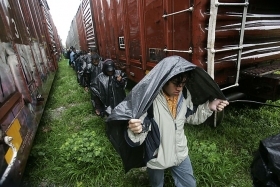A substantial drop in undocumented immigration from Mexico to the United States, but is this really due to Mexicans staying home to enjoy rising prosperity, or are there other factors at play?
According to a 2010 Department of Homeland Security report, the number of undocumented immigrants living in the United States declined from 11.6 million in 2008 to 10.6 million in 2009, the largest decrease in 30 years. One of the most common explanations for this phenomenon is that Mexico has witnessed the emergence of a middle class, lessening the economic incentive to cross the border. While it is true that a segment of the population has seen a growth in disposable income over the past five years, a July study by consulting firm De la Riva Group revealed that only 32 percent of the country is “middle class,” defined as making the equivalent of between 13,500 pesos ($1,000) and 98,499 pesos ($7,360) per month.
In contrast, the latest poverty statistics from Mexico’s government poverty monitor CONEVAL indicate that the number of people living below the poverty line in Mexico (2,114 pesos or $158 per month in urban areas, 1,329 pesos or $99 per month in the countryside) increased by 3.2 million between 2008 and 2010, and now stands at 52 million. This figure amounts to more than 46 percent of the country’s 112 million inhabitants. This directly contradicts optimistic accounts in the US media which imply that increasing standards of living in Mexico are causing immigration to fall, such as recently published articles in the Sacramento Bee and New York Times. While CONEVAL notes that a handful of states (notably Puebla, Coahuila and Morelos) have made some inroads against poverty, it cannot by any means be said that the country is mostly middle class.
Another commonly cited explanation for the reduction in undocumented migration is the surge in deportations under the Obama administration, which presents a further deterrent to those thinking about crossing the border. According to figures recently released by the Immigration and Customs Enforcement agency (ICE), a record 396,906 individuals were deported from October 2010 through September of this year. As a result of this trend, many individuals who continue to risk the perilous border crossing are seasoned experts who have crossed multiple times, often because they have families in the U.S. According to the New York Times, 56 percent of arrests at the Mexican border in 2010 involved people who had been caught previously, up from 44 percent in 2005.
But while stiffer immigration laws such as the “Secure Communities” initiative are doubtlessly contributing to the reduction in undocumented immigration, several recent reports have suggested that the primary reason for the drop is the drug war in Mexico. According to the Center for Comparative Immigration Studies’ director David Fitzgerald, the violence has become so great that potential migrants are no longer interested in risking their lives to make the trip. In a recent interview with Spanish news agency EFE, Fitzgerald claimed that surveys of migrant source communities in the states of Jalisco, Oaxaca and Yucatan reveal that the top concern among Mexican migrants is the level of violence along the border.
Fitzgerald’s remarks come just days after Salvador Beltran del Rio, the director of Mexico’s National Institute of Migration (INM), told local press that there had been an estimated reduction of nearly 70 percent·in the number of Central American migrants passing through the country in the past five years. Beltran’s estimate is based on the number of foreign migrants detained in Mexico, which has fallen from 433,000 in 2005 to 140,000 last year.
According to the official, this drop in Central Americans using Mexico as their gateway to the US is due to the threat from Mexican drug trafficking organizations, who have become increasingly involved in migrant smuggling. Out of every 10 migrants who attempt to go northward, according to Belran, six employ a “coyote,” who they pay to transport them across the U.S. border.
As InSight Crime has reported, these middlemen are increasingly in the service of the cartels, and frequently extort or kidnap the migrants, killing those who refuse to cooperate. Such was the fate of 72 Central American migrants in August 2010, who were found buried in a mass grave in the northern state of Tamaulipas. Sometimes the migrants are coerced into working for the cartels in order to pay for their passage, as evidenced by the recent discovery of 61 migrants who had been held in forced labor by the Zetas in Piedras Negras, Coahuila. With incidents such as these reported regularly along the border, it is no wonder that the incentive to travel al norte has reduced.

